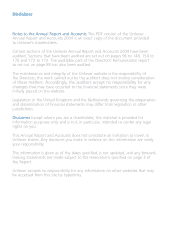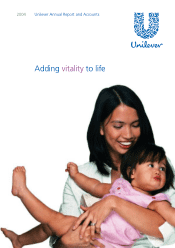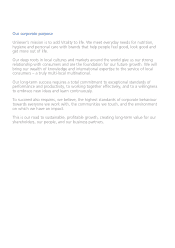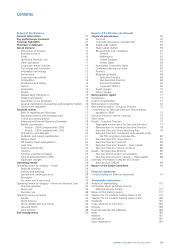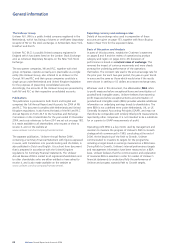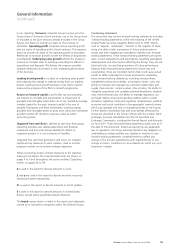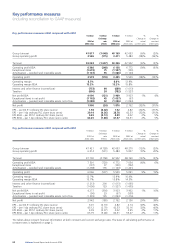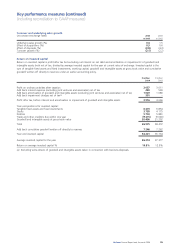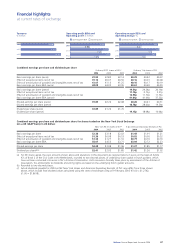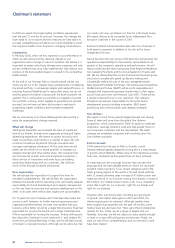Unilever 2004 Annual Report Download - page 11
Download and view the complete annual report
Please find page 11 of the 2004 Unilever annual report below. You can navigate through the pages in the report by either clicking on the pages listed below, or by using the keyword search tool below to find specific information within the annual report.08 Unilever Annual Report and Accounts 2004
Chairmen’s statement
In 2005 we expect the tough trading conditions experienced
over the past 12 months to continue. However, the changes we
have made to our structure and the measures we have taken to
increase competitiveness will allow us to retain flexibility to build
the long-term health of our business in changing circumstances.
Introduction
In February 2005, when we first reported on our performance in
2004, we also announced far-reaching changes to our
organisation and a change of roles for ourselves. We believe it is
important to explain why these changes were necessary and why
we are confident that, once fully implemented, they will put your
business in the best possible shape to succeed in the competitive
battles ahead.
At the end of our five-year Path to Growth period we are not
where we set out to be. Despite many achievements in simplifying
the brand portfolio, in increasing margins and capital efficiency, in
restoring financial flexibility and in many other areas, we do not
end this period of Unilever’s history with the level of growth we
wanted. This is not because our portfolio is incapable of growth.
Our portfolio is strong, and is capable of generating the growth
we need, but we have not been fast enough in reacting to
toughening market conditions and increased competitive
challenges.
We are now facing up to these challenges and also putting in
place the organisational changes required.
What will change
Starting last September we increased the level of investment
behind our brands, through more aggressive pricing and higher
advertising expenditure. We intend to sustain this policy and
make our portfolio work harder in a number of ways. We will
continue to build our big brands through innovation and
increased marketplace investment. At the same time we will
better use the whole of our brand portfolio to leverage our
category strength and drive market share. We recognize that
we must also be smarter and more disciplined in execution –
faster roll-out of innovations and more focus on building
productive relationships with our customers. We will fund
much of this through increased productivity.
New organisation
We will reshape the organisation to support the drive for
increased competitiveness. We will de-layer the organisation
between the Boards and the operating units, and clearly separate
responsibility for brand development and category management
on the one hand and country and customer development on the
other. In all cases there will be clear single-point accountability.
For 75 years the Joint Chairmen and Chief Executive model has
served us well. However, to further improve governance and
organisational effectiveness, we have now decided that your
business will be better served by a single Non-Executive Chairman
responsible for running the Boards and a single Chief Executive
Officer responsible for running the business. Antony will become
Non-Executive Chairman for both Unilever N.V. and Unilever PLC
at the Annual General Meetings in May, and he will lead a study
of Unilever’s corporate structure. Although our structure has met
our needs until now, we believe it is time for a thorough review.
We expect Antony to be succeeded by an independent Non-
Executive Chairman in the course of 2007.
Bertrand Collomb will become Non-Executive Vice-Chairman of
both parent companies in addition to his role as the Senior
Independent Director.
Patrick becomes the new Group Chief Executive and assumes full
operational responsibility for the business, accountable for all
aspects of the company’s operations and performance. He will
lead a small Executive team comprising three Regional Presidents,
two Category Presidents and functional leaders for Finance and
HR. We are dismantling the current divisional and business group
structures to simplify and speed up decision making and
substantially reduce the size of the top management team.
New Regional Presidents for Europe, The Americas and Asia/Africa,
Middle East and Turkey (AMET) will be profit responsible and
charged with implementing proven brand mixes in their region
across Foods and Home and Personal Care (HPC). There will be
a greatly enhanced focus on our customers. The Category
Presidents will assume responsibility for the entire brand
development process including innovation, R&D, brand
positioning and communication and category strategies.
One Unilever
We expect to fund future growth largely through cost savings.
Some of these will come from the global One Unilever
programme, which commenced in 2004. Its goal is to eradicate
duplication, leverage Unilever’s scale and help people focus on
our consumers, customers and the marketplace. The latest
changes are completely congruent with and build upon the
One Unilever principles.
Path to Growth
2004 marked the final year of Path to Growth, a bold
transformational agenda designed to bring about a step change
in growth and profitability. While many of the milestones set have
been met, sustained top-line growth has not been achieved.
In many ways we are a stronger business than we were five
years ago and we have valuable assets on which we can build –
excellent market positions in our chosen categories and in the
faster growing regions of the world; a focused brand portfolio
with 12 brands achieving sales in excess of €1 billion a year and
nearly two-thirds of our turnover coming from brands in excess of
€0.5 billion. Our Vitality mission unites us all. It is a compelling
vision that is right for our consumer, right for our brands and
right for our business.
However, after a promising start, including two good years
of growth and market share gains in 2001 and 2002, the
initial progress was not sustained. Although markets have
been tougher than expected over the past 18 months, some
market share has also been lost. There were three fundamental
reasons for this. Firstly, we let a range of targets limit our
flexibility. Secondly, we did not adjust our plans quickly enough
to react to a more difficult business environment. Finally, we
took our eye off our competitiveness, and our execution could
have been sharper.

